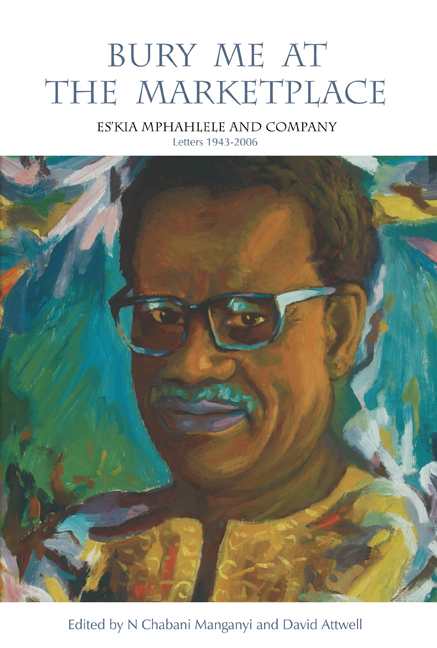Book contents
- Frontmatter
- Dedication
- Contents
- The Editors
- Acknowledgements
- Preface: In his Own Voice
- Introduction: Reading in the company of Es'kia Mphahlele
- Correspondents
- 1943
- 1944
- 1948
- 1952
- 1953
- 1954
- 1955
- 1957
- 1958
- 1959
- 1960
- 1961
- 1962
- 1963
- 1964
- 1965
- 1966
- 1967
- 1968
- 1969
- 1970
- 1971
- 1972
- 1973
- 1974
- 1975
- 1976
- 1977
- 1978
- 1979
- 1980
- 1981
- 1982
- 1983
- 1985
- 1987
- 1997
- 2000
- 2002
- 2005
- 2006
- Interviews: Looking In: In Search of Es'kia Mphahlele
- Metaphors of Self
- Interview References
- Index
Preface: In his Own Voice
Published online by Cambridge University Press: 04 June 2019
- Frontmatter
- Dedication
- Contents
- The Editors
- Acknowledgements
- Preface: In his Own Voice
- Introduction: Reading in the company of Es'kia Mphahlele
- Correspondents
- 1943
- 1944
- 1948
- 1952
- 1953
- 1954
- 1955
- 1957
- 1958
- 1959
- 1960
- 1961
- 1962
- 1963
- 1964
- 1965
- 1966
- 1967
- 1968
- 1969
- 1970
- 1971
- 1972
- 1973
- 1974
- 1975
- 1976
- 1977
- 1978
- 1979
- 1980
- 1981
- 1982
- 1983
- 1985
- 1987
- 1997
- 2000
- 2002
- 2005
- 2006
- Interviews: Looking In: In Search of Es'kia Mphahlele
- Metaphors of Self
- Interview References
- Index
Summary
The first edition of this book was a companion volume to my biography of Es'kia Mphahlele entitled Exiles and Homecomings.
At the time the books were published there was a small group of enterprising and progressive alternative publishers in Johannesburg, among them, Ravan Press and Skotaville Publishers, who supported the anti-establishment voices of the day. In my introduction to the first edition of Bury Me at the Marketplace I wrote that from a biographer's point of view the letters were a worthy companion to Exiles and Homecomings, a standpoint I maintain today.
I wrote, too, that Mphahlele's letters told the ‘story of a life lived’ to the fullest possible extent and were an invitation to enter into ‘a privileged inner circle of intimacy, humour, compassion, love and pain’. Significantly, at that time, I raised the prospect of a future edition of letters from and to Es'kia Mphahlele, a hope that has been realised with the publication of this edition. Work on this book has been in progress for a number of years and I have been privileged during that time to collaborate with David Attwell, an eminent scholar with a well-established understanding and knowledge of Mphahlele's literary oeuvre within the broader context of South African literature as a whole.
While working on the manuscript of this collection I felt as challenged as I was in the early 1980s when I engaged with and responded to the many faces of Es'kia Mphahlele as he took centre stage in different situations, countries and in relationships with a cast of illustrious writers, academics, friends and family coupled with his emergence as a world figure – a literary and cultural critic and significant writer in his own right.
One of the most important lessons I learnt is that memorable moments in letter writing come to light whenever a letter or set of letters gives the reader as much pleasure as it did the writer at the time of its composition. I have come to the conclusion, following a close reading of Mphahlele's letters, that a well-written letter makes demands on the writer that are similar to those normally associated with short-story writing. Letters which are to command the reader's undivided attention must feel self-contained, reflect a moment of cognitive and affective concentration and confirm the importance of an ability to create an atmosphere similar to that found in good short stories.
- Type
- Chapter
- Information
- Bury Me at the MarketplaceEs'kia Mphahlele and Company: Letters 1943-2006, pp. 1 - 5Publisher: Wits University PressPrint publication year: 2009

